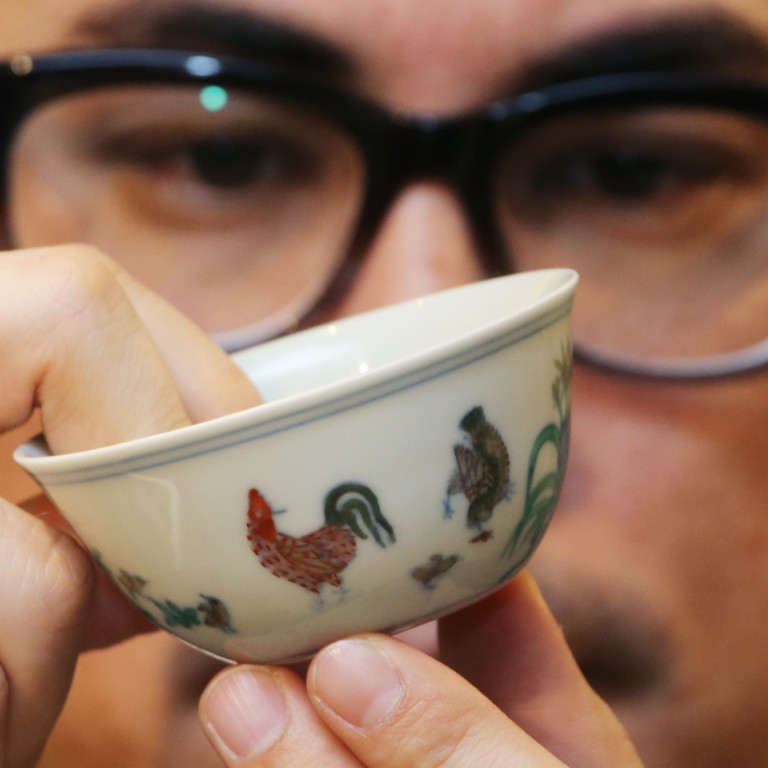
Boom in Chinese art has roots in traditional passion for collecting
Patrick Lecomte says rising wealth in China is not the only reason for record prices at auctions
In recent years, Hong Kong has become the theatre of an epic drama that comes back twice a year and lasts for a few days only: the seasonal auctions of Chinese ceramics and works of art. What makes these sales so riveting is the slew of records that they break, in addition to the discovery or rediscovery of fantastic works of art.
On April 8, a "chicken cup" was sold at Sotheby's for the world record price for a Chinese ceramic of HK$281.24 million to Shanghai-based collector Liu Yiqian. Since the same cup was sold for HK$29.17 million in 1999 at Sotheby's Hong Kong, its recent resale yielded a return of 864 per cent over 15 years.
Auction houses combining with unparalleled commercial hype and scholarship have been very successful at tapping into wealthy mainland Chinese collectors' insatiable appetite for classical Chinese art. But, once the applause and excitement have abated, do record prices paid by Chinese collectors make sense?
Since the early 2000s, Chinese collectors have taken the art world by storm. In its latest report on the global art market, the European Fine Art Foundation estimates that the overall market for artworks sold through auctions and galleries amounted to €47.4 billion (HK$498 billion) last year, with the US and China coming first and second with 38 per cent and 24 per cent of the global market respectively.
In less than 10 years, China has become the second-largest art market in the world. The global presence of Chinese collectors with seemingly unlimited means is being felt in every part of the market: at auctions, art fairs and galleries, in Hong Kong, Paris, London and New York. No segment of the art market is more influenced by mainland collectors than classical Chinese paintings, ceramics and works of art. Tellingly, four out of seven prices above €1 million at French auctions over the past six months were registered for Chinese works of art.
There are several reasons to explain China's art rush. First, China's staggering economic growth has enabled the accumulation of wealth by an ever increasing number who invest in the best art works the international market has to offer, primarily Chinese art. Their motivations might be artistic as well as financial.
Secondly, Chinese collectors feel it is their national duty to bring back to the mainland artefacts which were scattered all over the world, partly as a result of Western countries' less than glorious deeds during the troubled last decades of the Qing dynasty.
Indeed, few countries have seen their heritage as systematically looted and smuggled abroad as China in the late 19th century and first half of the 20th century. Bringing home a national treasure was the first thing that Liu Yiqian mentioned after announcing he was the winning bidder of the "chicken cup".
Such aspirations are not only a way to mend the wrongs suffered by China but also a sentiment rooted in Chinese history. For centuries, the prestige of imperial collections was linked to the strength of the empire, in particular through the collecting of archaic bronzes, which embodied supernatural connections with former dynasties. Hence, China's renaissance implies a re-appropriation of its prestigious cultural past. In countries with a long and rich history, art is instrumental in defining the concept of nation.
Last but not least, art collecting is a Chinese passion as old as China itself. The first documented collection was that of the Emperor Wu of Han, who assembled a staggering ensemble of treasures in his Shanglin garden more than 2,000 years ago. Ming scholars and literati competed for artworks and wrote treatises on the art of collecting "superfluous things".
As the country got richer during the Qing dynasty, art collecting became a desirable habit for those aspiring to social cachet. The art market boomed and numerous works of exquisite craftsmanship were produced. Contemporary collectors are part of this prestigious lineage of scholars and passionate collectors.
Given these economic and sociological factors, observers of the current art market craze might find it difficult to define what the right price should be for Chinese antiques. If history can teach us anything, it is that top-quality Chinese artworks have always been highly sought after and expensive.
Interestingly, records show that during the Ming dynasty, the highest price paid for any work of art was 1,000 ounces of silver for a painting by Yuan dynasty artist Huang Gongwang (, currently in the National Palace Museum's collections in Taiwan) in a transaction in 1630. As a matter of comparison, at that time, the price of a reasonably large city house was 200 ounces of silver, and a hectare of prime agricultural land was worth between 28 and 40 ounces, which makes this painting a worthy forebear to the record prices witnessed today.
